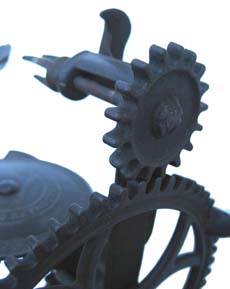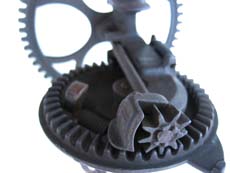Gear
Ratios
 In
this inverted Reading (left) a larger hand-driven gear meshes with
a smaller gear turning the fork, which provides a speed advantage.
With one turn
of the hand-driven gear, the fork and apple rotate many times. One
can determine just how many times by calculating the gear ratio.
The gear
ratio can be determined by counting the teeth on the gears. In this
case, the hand-driven gear has 55 teeth and the fork gear has 17.
Divide 55 by 17 and you can see the apple will rotate 3.2 times
for every
complete turn of the hand-driven gear. In
this inverted Reading (left) a larger hand-driven gear meshes with
a smaller gear turning the fork, which provides a speed advantage.
With one turn
of the hand-driven gear, the fork and apple rotate many times. One
can determine just how many times by calculating the gear ratio.
The gear
ratio can be determined by counting the teeth on the gears. In this
case, the hand-driven gear has 55 teeth and the fork gear has 17.
Divide 55 by 17 and you can see the apple will rotate 3.2 times
for every
complete turn of the hand-driven gear.
 In
this same parer a steel axle connects the hand-driven gear to a smaller
table gear (pictured to the right). Even though the two gears are of
different size they rotate at the same rate because they are on the
same axle. The smaller table gear rotates
a larger
turntable gear, which provides a mechanical advantage. We can determine
how many times the hand-driven gear/shaft/table gear assembly must
be turned to rotate the turntable one time by calculating the gear ratio.
The turntable has 45 teeth and the small table gear rotating it
has 9 teeth. Divide 45 by 9 and we can see the small table gear
and hence the hand-driven gear must make 5 complete turns to rotate the
turntable once. So, roughly half of these 5 turns will be used to pare
the apple and the remaining turns used to place the paring blade back
into starting position. In
this same parer a steel axle connects the hand-driven gear to a smaller
table gear (pictured to the right). Even though the two gears are of
different size they rotate at the same rate because they are on the
same axle. The smaller table gear rotates
a larger
turntable gear, which provides a mechanical advantage. We can determine
how many times the hand-driven gear/shaft/table gear assembly must
be turned to rotate the turntable one time by calculating the gear ratio.
The turntable has 45 teeth and the small table gear rotating it
has 9 teeth. Divide 45 by 9 and we can see the small table gear
and hence the hand-driven gear must make 5 complete turns to rotate the
turntable once. So, roughly half of these 5 turns will be used to pare
the apple and the remaining turns used to place the paring blade back
into starting position.
The
axle of the small table gear is at a 90-degree angle from the
axle of the larger turntable gear. This gear arrangement is used
to change the direction of motion.
|

